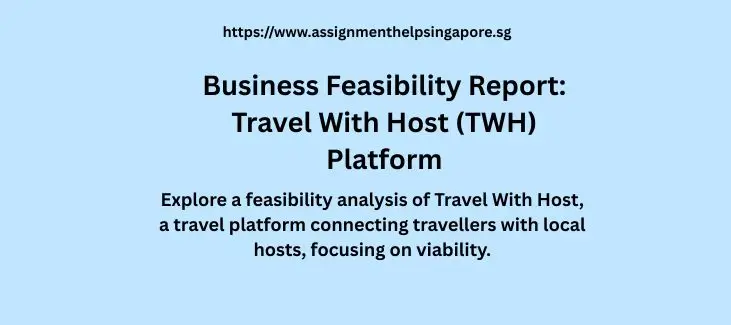
Contents
Business Feasibility Report: Travel With Host (TWH) Platform
Question 1
In the global travel industry, a significant trend is emerging: Personalised and Authentic Experiences (Vazan, 2024). Modern travellers are increasingly seeking custom-tailored trips that emphasise cultural immersion and unique adventures. This includes activities such as wellness retreats, culinary tours, and visits to off-the-beaten-path destinations that prioritise authenticity and personalisation.
Recognising a business opportunity in this global trend, you and two friends are considering creating a leisure travel platform, naming it “Travel With Host” (TWH). The platform would match travellers with local residents who act as hosts, offering services such as accommodation, personalised travel guidance, and/or transportation. The business model centres on providing a “matching service” where local hosts predefine the services they offer,
making the platform a comprehensive solution for personalised travel needs.
The platform’s revenue stream would be based on commissions (platform fees) from the transactions between travellers and hosts. To facilitate this, the TWH platform will include integrated credit card payment features, ensuring secure and seamless financial transactions. TWH will collect payment from the travellers upon confirmation and pay the hosts after deducting commissions.
Among the team, one member has expertise in software development and will design and build the initial version of the website and mobile application. The other two members will focus on the commercial aspects of the business, including marketing, partnerships, and customer acquisition.
The team collectively sees immense potential in this venture, with opportunities to upsell related travel products, such as attraction tickets, travel insurance etc., and the possibility of scaling the business to other countries. Although each member’s initial contribution of $15,000 as start-up capital may be modest, the team believes the business idea is innovative and has the potential to succeed if approached strategically.
However, the team acknowledges the challenges posed by the lack of a proven track record and experience, which makes securing bank loans or equity financing nearly impossible during the start-up phase.
To mitigate risks, the team plans to use a Validation Board to thoroughly appraise and test the business idea before committing further time and resources. This step is essential to ensure the concept is viable and has a strong foundation for success.
Required:
You are required to analyse the information given above, and develop a Business Feasibility Assessment Report in a report format with the following sections:
| Section | Title & Contents | Marks |
|---|---|---|
| 1 | Executive Summary (1 page)Prepare a summary of the various key points of the validation board exercise, main findings, and conclusion on the business viability and next steps, if any. | 10 |
| 2 | Validation Board (1 page)Construct a Validation Board based on the prescribed format.The Validation Board should show the key points in the various required boxes. | 10 |
| 3 | Validation Board Details (3 – 4 pages)Explain in narrative (proper paragraphs) for each of the following:(a) Customer Hypothesis(b) Problem Hypothesis(c) Core AssumptionsDescribe five (5) core assumptions, with suitable explanations and ranked from the most to the least risky.Identify and explain the riskiest assumption, and why it is selected for validation and the implication to the business if it not well tested. | 60(total) 8715 |
| (d) Method (i.e., Design Experiment)Explain how you would use a prototype website to fulfil the minimum set of features to be released during launch date, i.e., Lean Startup Model.Describe the method you would use to validate this prototype website against your assumptions.(e) Minimum Success CriteriaExplain, with suitable justifications, the criteria that should be met to validate/invalidate your assumptions.(f) Validated AssumptionSelect the first and riskiest core assumptions made and assume that it is validated and explain why it is validated.(g) Invalidating Assumption and First PivotSelect the second core assumptions made and assume that it is invalidated; you can provide any reasonable assumptions so that you can create and describe the first pivot.Describe, for the first pivot: (i) the Customer Hypothesis, (ii) the Problem Hypothesis (iii) Solution Hypothesis. | 10 5 5 10 | |
| 4 | Starting the Business (1-2 pages)Describe how you would proceed to develop the first version of the TWH platform as a “Minimum Viable Product (MVP)” and describe how the workflow and payment processes will be integrated in the MVP.Appraise the capital constraints and use the Lean Startup Model to explain how your team may be able to start the business venture, including areas of major expenditure requirements. | 15 |
| 5 | Conclusion (1 page)Appraise and provide a suitable conclusion to the viability of the business and state the next steps to be taken if any. | 5 |
Get Management Answers: Expert Answers on Above Questions on Business Feasibility
Executive Summary
Travel With Host (TWH) is based on the important concept of matching travellers with local residents who became the host. They are responsible for providing accommodation, personalised travel guidance and transportation. The main focus of this business concept is therefore on tapping the rising demand for personalized and authentic travel. The key risks for this business include the reliability factor, the trust of customers and the readiness of adapting to technology. The business is identified as highly prominent provided the risks are efficiently addressed.
Validation board
Customer hypothesis: Customer wants personalized experience from local people.
Problem hypothesis: Customers may hesitate in believing the locals and trust factor could be a major problem.
Solution hypothesis: A technology platform supported by a reputed brand name to establish trust factor among customers.
Risk/assumption: The assumption made is the availability of demand and higher possibility of technological adoption among customers.
Experiment: Designing a prototype to test the business concept before finalizing it.
Starting the business
To start up the business, it is important to perform a prototype design with a simple website with host profiles, a proper process of booking local guides with a proper functional payment system.
The work flow would be to get a deposit first from the traveller, and the host will get the payment after the feedback from the traveller.
The capital constraint would be to get initial funding for Website development, marketing and payment integration.
| Disclaimer: This answer is a model for study and reference purposes only. Please do not submit it as your own work. |
Want a Full Worked Out Answer with References?
Check Samples on Management Subject Written by Experts
Related answers
Service Operations Management Evaluation – Singapore
Innovation in Foldable and Stretchable Phone Displays
Workplace Wellbeing, PERMA Model & Leadership Styles
Customer Experience Management in Service Industry Singapore
Fresh Delights Case Study: Business Expansion, Marketing Mix, HR Strategy & Financial Planning



